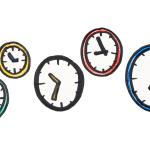Worry is a natural byproduct and characteristic of a leader. Here are five ways to cope with worrying as a leader.

The other week, I interviewed Jason Fried, CEO and co-founder of Basecamp. I asked him what he wish he would’ve learned earlier as a leader.
His response? Worry less.
I smiled when he said this. Oh, how I could relate!
Over the past few years, I’ve noticed how many CEOs (myself included) are stressed out and worried about something. They’re worried about employees leaving, internal team conflict, growing fast enough, their product failing, the market changing, the competition beating them, running out of money, hiring great people…
The list of worries seemingly has no end.
But how do we put an end to it? Personally, I know I’d like to worry less. I think more clearly, act more intentionally, and enjoy life a hell of a lot more when I’m less worried.
In an effort to worry less as a leader, I decided to write out what works for me. Here are five things I try to keep in mind to worry less:
Ask yourself: “What’s the most I can do with what I have right now?”
Most of my worry stems from feeling a lack of control over a situation. I want something to turn out a certain way. So I start to feel overwhelmed and worried when I don’t believe I have the agency to influence that outcome. Here’s the funny thing, though: We have more control than we think. We can control ourselves — our actions, reactions, decisions, and beliefs. What we can’t control are other people and external events. And if that’s the case, well, why bother worrying about them?
Let’s choose to focus on the former: The things we can control.
To do this, a helpful question I like to ask myself is, “What’s the most I can do with what I have right now?” This question re-focuses my energy on what I am in control of right now. Instead of idling in indecision and mulling over every possible path and course of action, the question “What’s the most I can do with what I have right now?” forces your hand. You must deal with the cards in front of you. And once you do, you’ll clear a path to move forward within the constraints you have. Now you can focus on what you can control.
Remind yourself that the present is real — the future isn’t.
My worry also comes from my mind operating too much in the future. I think, “What if…” or “That could happen…” and brace myself for a future scenario, trying to strategize two steps ahead of it. While in some ways that can be beneficial for thinking through certain complex decisions, it is enormously distracting, for the most-part. The only thing that’s real is what is happening now. The present is real. The future isn’t real yet. It hasn’t happened. Remembering that always lightens the load of my worries.
Realize how good you have it.
When I stop for a minute and look at my life, I realize how goddamn lucky I am. Lucky that I was born in this country, to have the parents that I have, to go to the schools that I did, to meet the people I have across my career… I hope I’m not the only person who feels this way. So many of us, even in our worst, most pained, stressed, and worried work moments, live lives that 99% of the world would trade places with in an instant.
Of course, it’s tough to remember when we fall victim to our own worry-ridden train of thought. To combat this, at the end of every day, I try to think of three specific moments earlier that day when I felt joy or gratitude. (Studies have shown that in fact writing down daily what you’re grateful for significantly reduces stress in people.) I realize that I’ve got it good — and so many of us do.
Share your worries.
Tell other people what your worries are. It does no good to suffer in silence. Often times, when I say my worries aloud to another person, it becomes immediately apparent how stupid that worry is, how pointless it is… and the worry evaporates. If it doesn’t, at the very least, you now have a confidant, a pal, who you can think things through with and discuss a plan of action around. Don’t keep worries to yourself. Share ‘em.
Step away, move your body, get some sleep.
My worries become exacerbated when I don’t take care of my mind and my body. When I’m in a particularly stressful or worrisome situation, usually the best thing is to take a step back, get my body moving, and go do something different. Go for a walk. Get on a bike. Breathe some fresh air. Go surround yourself with greenery, or good music. Talk to a sibling, parent, friend, boyfriend, or spouse about something completely non-work related. And get some sleep. Rest the mind, rest the body. The break is needed. I always return feeling clearer and fresher on what matters.
I hope these tactics may be as helpful to you as they’ve been for me.
If anything, as I shared with Jason during our interview, do keep in mind what a friend once told me:
“Worry is the most useless emotion.”
✨Looking for ways to regain your footing as a manager? You’ll want to check out Know Your Team. Our software gives you tools to become a better manager, even if you’re not quite feeling 100% yourself. We help you run effective 1:1 meetings, build rapport with your team, and more. Give Know Your Team a try today.




